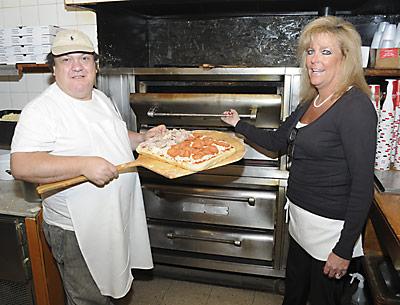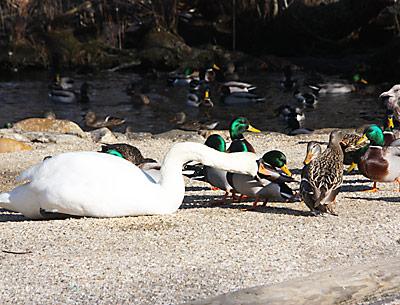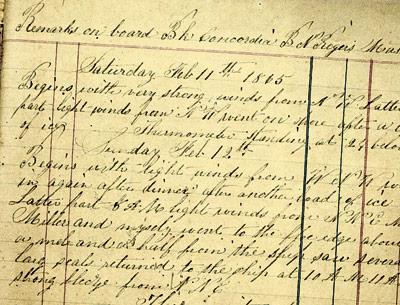Taking the Year-Round Gamble
Taking the Year-Round Gamble

For Alda Lupo Stipanov, these are the cruelest months.
If the decision were hers and hers alone, she would shutter the green doors of Astro’s Pizza and Felice’s Ristorante in October and not reopen them again until April. But every September, she finds herself on the losing side of the same argument.
After immigrating from Italy, her parents started the Amagansett eatery 42 years ago. Ms. Stipanov now oversees the family-run pizzeria and adjoining restaurant alongside her brother, Tony Lupo, and her husband, Nado Stipanov.
“Every year, it’s the same debate. I want to close. They want to stay open. Financially, it’s a drain. We’re not making any money,” Ms. Stipanov said during a recent afternoon lull. “In the summer, we make up for lost time. We really try to stay open for the community. Where else are they going to go?”
Particularly during the off-season, it’s a quandary faced by many local shopkeepers — namely, the economic gamble of whether to stay open.
Peter Honerkamp, a founder and managing partner of the Stephen Talkhouse in Amagansett, a nightclub he’s overseen for the past 27 years, said that it has never made financial sense to stay open during January and February.
“You can eke by in the winter, but just barely,” Mr. Honerkamp said, adding that most businesses that stay open do so for the staff and for the community — but never the bottom line.
“There’s no way to make money in January and February. We make our money from May to October,” said Mr. Honerkamp. “It always sucks six months of the year. The rest of the time it’s always been a joke. It was a joke 27 years ago and it’s a joke now.”
Over the years, though he’s seen more businesses attempting to stay open year round, he said that none do so without financial strain. Unlike in past years, the Talkhouse is now closed until early March, while it undergoes renovations. During the time off, Mr. Honerkamp said, he plans to compensate his small staff for any lost wages.
Marina Van, the executive director of the East Hampton Chamber of Commerce, sees many shops closing midweek, particularly on Tuesdays and Wednesdays.
“As far as closing totally, many are calculating whether it’s worth staying open,” Ms. Van said. “Is it worth keeping a staff or better to just open again when the fishing is good?”
Apart from building a ski mountain and becoming a winter destination, Ms. Van sees the South Fork as a destination in summertime, when the population roughly doubles. Though an exact summer figure is unknown, in 2010 the U.S. Census Bureau estimated East Hampton Town’s year-round population around 21,000.
A recent midweek scan of Main Street in East Hampton Village yielded 10 empty storefronts, with several businesses, such as Lululemon Athletica and Steven Alan, closed on Tuesdays and Wednesdays, and many others shuttered until warmer temperatures return.
But Mark Smith, who owns Nick and Toni’s, La Fondita, Rowdy Hall, and Townline BBQ restaurants, sees the area as an increasingly year-round place, particularly in the years since Sept. 11, 2001.
As his company has 100 employees on its payroll, he feels an obligation to stay open. Besides the “real, emotional, and philosophical” costs of hiring and then rehiring a staff every season, he can’t imagine starting again every spring from scratch.
Rather than close entirely, some of his restaurants have cut back on days and hours. While La Fondita, for instance, is now open five days a week, Rowdy Hall stays open seven days a week. After Memorial Day, Mr. Smith said, the businesses will again open seven days a week, with most dropping back down to five days after the Thanksgiving holiday.
As a year-round resident himself, Mr. Smith sees far fewer retail stores remaining open during the winter months. “It’s sort of a shame,” he said. “Some of the soul and character of East Hampton, the sense that we’re living in a village, has been lost by virtue of it.”
Eighteen years ago, Mary Schoenlein, a food business veteran, moved here from New York City. Twelve years ago, she opened Mary’s Marvelous in Amagansett. A year and a half ago, she opened a second location in East Hampton. Both stores are open year round, with the Amagansett location currently closed on Wednesdays, its slowest day.
“Because I am a local, I felt it was important to stay open,” said Ms. Schoenlein, a resident of Springs, during a recent afternoon break from overseeing the kitchen. She wore a white apron and black clogs, her hair tied back in a bandanna. “When I opened the business, that was the goal. We need local support in order to survive.”
So far, local support has fueled the East Hampton location with a steady stream of devoted weekly clientele. Weekends are still the store’s slowest time, with Sundays particularly quiet.
Between the two stores, Mary’s Marvelous now has 28 employees on its payroll, a mixture of full-time and part-time workers whose ranks swell during the summer months to meet the growing demand for coffee and baked goods, among other sweet and savory treats.
Still, Ms. Schoenlein is the first to concede that these are difficult economic times. “The typical pattern for us is that we do very well in the summer, with the summer income paying for a few months, and then we hit a very lean time. From now until May, it’s tough,” she said. “Every customer counts. You can go to six different places to get a muffin and a cup of coffee.”
Mostly, though, she can’t imagine closing every season only to hire and train a new fleet of workers. There’s also a sense of pride, being one in a dwindling number of locally owned businesses — the ones who continue to persevere and stay open, year after year.
“We survive. We sustain ourselves. There are people who rely on us,” Ms. Schoenlein said. “There’s a warming feeling when you drive through town and the lights are on at Mary’s and you can stop in and get something to eat.”




